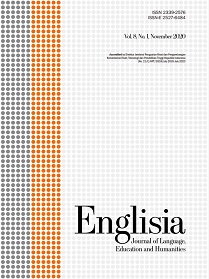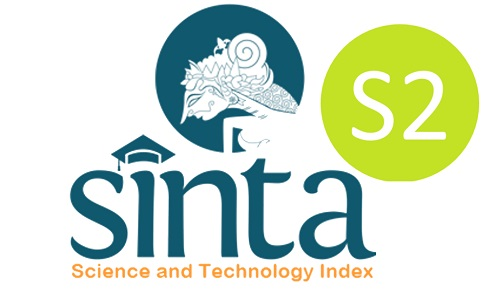EFL learners’ code-switching: Why do they switch the language?
DOI:
https://doi.org/10.22373/ej.v8i1.6662Keywords:
code-switching, EFL learners, interaction.Abstract
This qualitative study aims to figure out the factors that influence EFL learners’ code-switching. In collecting data, a semi-structured interview was conducted which involved five EFL learners as the participants. Those participants were selected through the purposive sampling method: being second-semester students of the English Language Education Department of Universitas Islam Negeri Ar-Raniry, and taking Basic Speaking class. Semi-structured interviewed was applied to collect the data needed. The finding of this study showed that all participants employed code-switching in their class. The reasons for EFL learners’ code-switching were influenced by participants’ roles and relationships, selected topics, and interactions. Thus, code-switching was regarded as a useful strategy that helped the learners convey their ideas to be fully understood and meaningful in the interaction process.
Downloads
References
Al Hayek, R. (2016). Arabic–English code-mixing by Jordanian university students (Doctoral dissertation). Retrieved from https://researchdirect.westernsydney.edu.au/islandora/object/uws:36867/datastream/PDF/download/citation.pdf.
Al-Heeti, N. H., & Al-Abdely, A. A. (2016). Types and functions of code-switching in the English language used by Iraqi doctors in formal settings. International Journal of Advanced Research and Review, 1(8), 10-18.
Bani Bili, Y. R. (2017). Social factors prompting adult bilingual speakers to code switch. Englisia: Journal of Language, Education, and Humanities, 4(2), 90-98.
Bista, K. (2010). Factors of code-switching among bilingual English students in the university classroom: A survey. English for Specific Purposes World, 9(29), 1-19.
Boztepe, E. (2003). Issues in code-switching: Competing theories and models. Studies in Applied Linguistics and TESOL, 3(2), 1-27.
Chin, B. N., & Wigglesworth, G. (2007). Bilingualism: An advanced resource book. London, UK: Routledge.
Creswell, J. W. (2014). Research design: Qualitative, quantitative and mixed methods approaches (4th ed.). Thousand Oaks, CA: Sage.
Grima, A. C. (2013). Challenging code-switching in Malta. Revue Française de Linguistique Appliquée, 18(2), 45-61.
Halim, N. S., & Maros, M. (2014). The functions of code-switching in Facebook interactions. SoLLs.INTEC.13: International conference on knowledge-innovation-excellence: Synergy in language research and practice. Procedia - Social and Behavioral Sciences, 118, 126-133.
Hasan, M. K., & Akhand, M. M. (2015). Reviewing the challenges and opportunities presented by code-switching and mixing in Bangla. Journal of Education and Practice, 6 (1), 103-109.
Heltai, P. (2018). Transfer and code-switching. Retrieved from https://www.researchgate.net/publication/324941754_
Holmes, J. (2008). An introduction to sociolinguistics (3rd ed.). Harlow, UK: Pearson Education.
Horasan, S. (2014) Code-switching in EFL classrooms and the perceptions of the students and teachers. Journal of Language and Linguistic Studies, 10(1), 31-45.
Khaerunnisa, L. (2016). An EFL teacher’s code switching in a young learners’ class. Indonesian Journal of EFL and Linguistics, 1(1), 13-31, http://dx.doi.org/10.21462/ijefll.v1i1.1
Kim, E. (2006). Reasons and motivations for code-mixing and code-switching. EFL Journal, 4(1), 43-61.
Liu, D., Ahn, G. S., Baek, K. S., & Ok. N. (2004). South Korean high school English teachers' code-switching: Questions and challenges in the drive for maximal use of English in teaching. TESOL Quarterly, 38(4), 605-638.
Mabule, D. R. (2015). What is this? Is it code-switching, code mixing or language alternating? Journal of Educational and Social Research, 5(1), 339-350.
Mukti, T. P., & Muljani, R. (2016). Code-switching in the snstructions of English language education study program lecturers. LLT Journal, 19(1), 47-60.
Rinda, R. K. (2014). A study of code-switching of teacher talk on trainee teacher in PPL II program of state university of Surabaya. RETAIN, 2(1), 1-10.
Sadighian, S., & Rahmi, A. (2011). Code-switching and social prestige: Code-switching among Iranian university learners. Academic Leadership: The Online Journal, 9(3), 1-8.
Saraswati, R. & Octavita, R. A. I. (2016). A study of English code-switching in Indonesian teen magazine. DEIKSIS, 8(1), 39-47.
Sharma, G. (2017). Pros and cons of different sampling techniques. International Journal of Applied Research, 3(7), 749-752.
Shartiely, N. E. (2016). Code-switching in university classroom interaction: A case study of the University of Dar es Salaam. Stellenbosch Papers in Linguistics, 49, 215-231.
Suek, L. A. (2017). Code switching and the development of linguistic system of simultaneous bilingual children. Englisia: Journal of Language, Education, and Humanities, 5(1), 1-7.
Suganda, L. A., Loeneto, B. A., & Zuraida. (2018). Teachers’ use of code-switching in an English as a foreign language context in Indonesia. Script Journal: Journal of Linguistic and English Teaching 3(2), 111-126.
Trisnawati, I. K. (2017). Maintaining the identity of bilingual individuals in multicultural/multilingual settings. Englisia: Journal of Language, Education, and Humanities, 5(1), 8-16.
Wijayanti, W. (2014). Bahasa Indonesia/English code switching at USBI The Sampoerna University, Jakarta. Proceedings of International Conference on Economics, Education and Humanities (ICEEH'14) (pp. 101-104). Retrieved from http://icehm.org/upload/3923ED1214069.pdf
Yusuf, Y. Q., Fata, I. A., & Chyntia, C. (2018). Types of Indonesian-English code-switching employed in a novel. Kasetsart Journal of Social Sciences, 41(1), 208-213. https://doi.org/10.1016/j.kjss.2018.02.
Downloads
Published
Issue
Section
License
Proposed Policy for Journals That Offer Open Access
Authors who publish with Englisia journal agree to the following terms:
- Authors retain copyright and grant the journal right of first publication with the work simultaneously licensed under a Creative Commons Attribution License that allows others to share the work with an acknowledgement of the work's authorship and initial publication in this journal.
- Authors are able to enter into separate, additional contractual arrangements for the non-exclusive distribution of the journal's published version of the work (e.g., post it to an institutional repository or publish it in a book), with an acknowledgement of its initial publication in this journal.
- Authors are permitted and encouraged to post their work online (e.g., in institutional repositories or on their website) prior to and during the submission process, as it can lead to productive exchanges, as well as earlier and greater citation of published work (See The Effect of Open Access).









